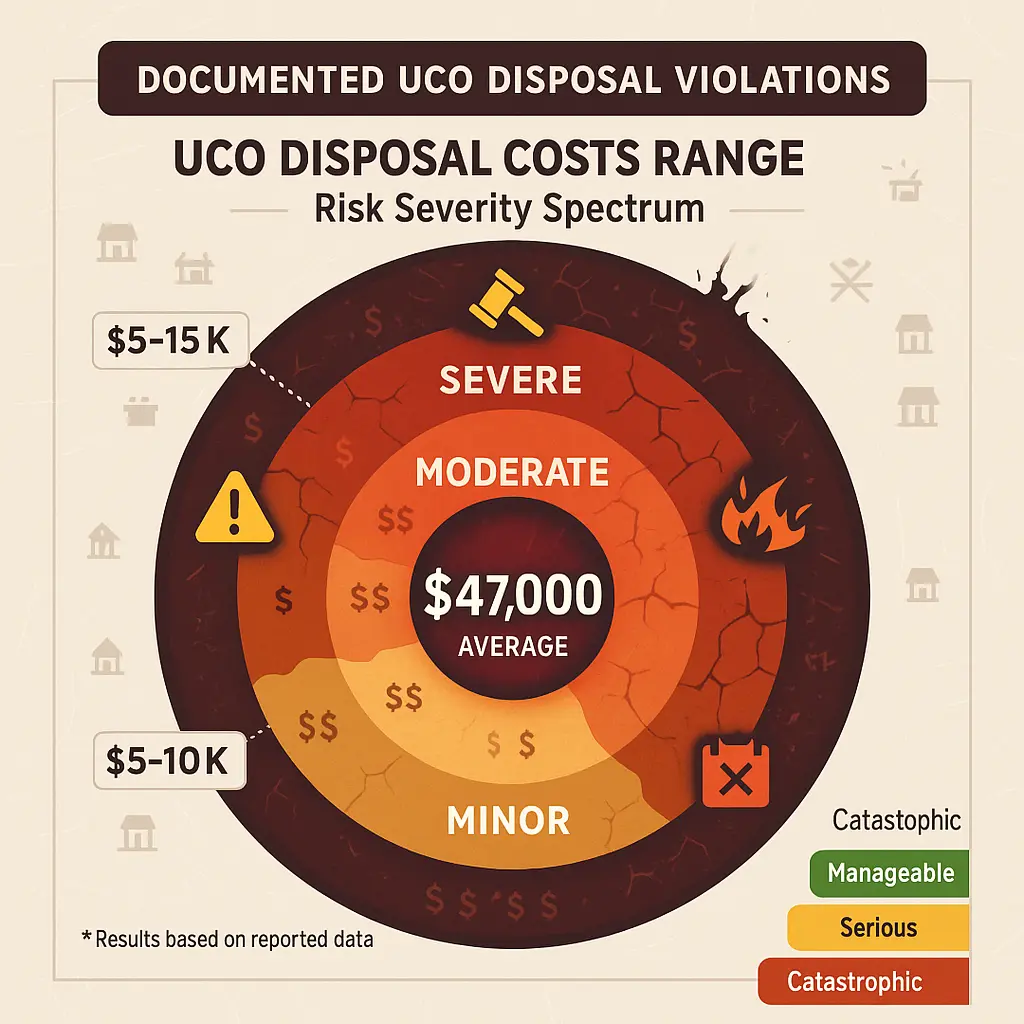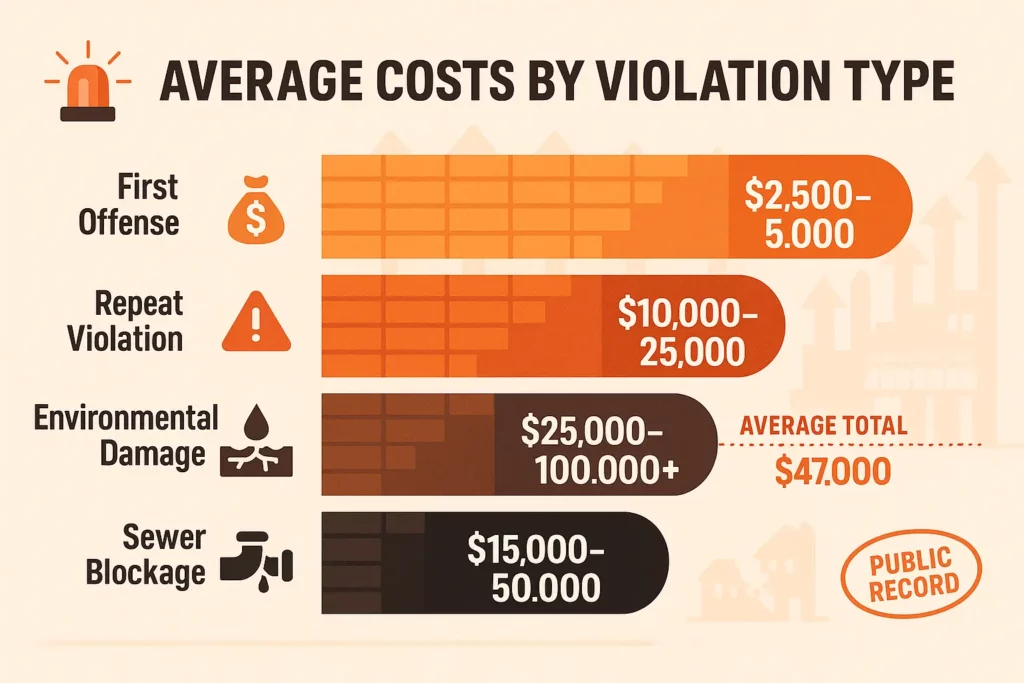Disclosure: This page provides information from Grease Connections, a company that offers used cooking oil recycling services. While we believe professional used cooking oil management is important, we recognize it’s one of several valid approaches to compliance. The cost figures presented represent documented cases but individual experiences vary widely. We encourage you to evaluate all options—including prevention-only strategies, municipal programs, and various service providers—before making a decision. Critical evaluation of the information and consideration of multiple perspectives are strongly encouraged.
Table of Contents
Last month, a family-owned restaurant in Miami faced $32,000 in fines, cleanup costs, and lost revenue—all from one clogged grease trap. Their “cost-saving” disposal method? Dumping used cooking oil down the drain. They’re not alone. According to EPA enforcement data and industry reports, improper UCO disposal costs can range from $5,000 to over $100,000, with severe cases averaging $47,000 per incident.*
*These figures represent documented cases involving multiple violations, environmental damage, and extended closures. Individual incidents may cost significantly less or more depending on severity.

The Hidden Costs Nobody Talks About
Immediate Financial Impact
When restaurants cut corners on grease disposal, costs vary widely based on violation severity:
EPA Fines (per violation):
- First offense: $2,500-$5,000
- Repeat violations: $10,000-$25,000
- Environmental damage: Up to $37,500/day
Additional Costs:
- Emergency plumbing: $500-$15,000 (depending on blockage location)
- Health citations: $250-$2,000 (varies by state)
- Grease trap replacement: $1,500-$8,000 (size dependent)
- Lost revenue: $1,000-$20,000/day (based on restaurant size)
*Source: EPA enforcement database, National Restaurant Association data, and plumbing industry estimates
Long-term Business Damage
The financial hit extends far beyond immediate costs. Health violations become permanent public records, triggering negative online reviews that haunt your restaurant for years. Insurance companies raise premiums after claims, sometimes by 40% or more. Severe violations can result in permit suspension or license revocation. Environmental cleanup liability can reach six figures, and legal fees for defending against lawsuits average $15,000—win or lose.

Operational Disruptions
Picture this: It’s Friday night, your busiest service, and the kitchen floods with backed-up grease. You’re sending customers away, paying staff overtime for emergency cleanup, and operating a limited menu while equipment gets repaired. Angry customers demand compensation. Your team scrambles to manage the crisis instead of serving guests. The ripple effects last weeks after the pipes are fixed.
Why Restaurants Make This Costly Mistake

Lack of Understanding
Restaurant owners don’t realize that UCO solidifies in pipes, attracts pests, and violates federal regulations. What seems like harmless liquid becomes concrete-like FOG (fats, oils, grease) buildup that destroys plumbing systems. Hot water doesn’t help—it just pushes the problem downstream where it cools, hardens, and creates blockages affecting entire neighborhoods.

Understanding the True Cost Equation
Many operators face a genuine dilemma: professional disposal services cost $30-$75 monthly, which can strain tight budgets. However, consider the risk-adjusted cost:
DIY Disposal Hidden Costs:
- Staff time for disposal: 2-4 hours/month @ $15/hour = $30-$60
- Increased plumbing maintenance: $100-$200/month average
- Higher insurance premiums: $50-$150/month after claims
- Risk exposure: Even a 1% chance of a $15,000 incident = $150/month in risk
Professional Service Value:
- Typical cost: $30-$75/month
- Potential rebates: $0-$50/month (for 40+ gallons)
- Net cost: Often $0-$50/month
- Risk eliminated: Priceless
The math becomes clearer when comparing total cost of ownership rather than just service fees.
“It Won’t Happen to Me” Syndrome
After years without incident, complacency sets in. But enforcement is increasing—EPA violations rose 40% from 2021 to 2023. Municipal authorities face pressure to maintain sewer systems, leading to more aggressive enforcement. Anonymous complaints from competitors, disgruntled employees, or concerned neighbors can trigger investigations. Inspectors examine current practices and historical patterns, potentially uncovering years of violations.
The Smart Restaurant’s Approach to UCO Management

Start with Prevention: Best Practices Every Restaurant Must Implement
Before considering any disposal service, implement these zero-cost prevention strategies that reduce grease-related problems by up to 60% (National Restaurant Association data):
Daily Operations:
- Train ALL staff on the “nothing down the drain” rule
- Wipe down greasy equipment with paper towels before washing
- Install mesh strainers in all sinks to catch food particles
- Cool oil completely before any disposal method
- Post clear signage in multiple languages near disposal areas
Maintenance Practices:
- Schedule monthly grease trap inspections
- Maintain temperature logs for grease traps (keep below 90°F)
- Document all disposal activities for compliance
- Review procedures quarterly with staff
Choose Your Compliance Path: Four Valid Options
Option 1: Prevention-Only Approach
- Best for: Very low volume (<10 gallons/month)
- Requirements: Rigorous documentation and staff discipline
- Cost: $0 + staff time
- Risk: Higher without disposal documentation
Option 2: Municipal Drop-Off Programs
- Best for: 10-30 gallons/month with available transport
- Requirements: Vehicle, containers, staff time
- Cost: $30-$60/month in labor and transport
- Benefit: Free disposal at city facilities
Option 3: Shared Service Agreements
- Best for: Restaurants near other food service businesses
- Requirements: Coordination with neighbors
- Cost: $15-$30/month (split costs)
- Benefit: Professional service at reduced rate
Option 4: Professional Collection Service
- Best for: 40+ gallons/month or limited staff time
- Requirements: Space for container
- Cost: $30-$75/month (may include rebates)
- Benefit: Full compliance documentation and convenience
Understanding Rebate Economics
Realistic Rebate Expectations by Volume:
- Under 40 gallons: Typically no rebates
- 40-60 gallons: May break even on service costs
- 60-100 gallons: Usually see $10-$30 monthly rebates
- 100+ gallons: Can earn $30-$75+ monthly
Factors Affecting Rebates:
- Geographic location (urban areas pay more)
- Oil quality (clean oil commands premium)
- Market conditions (biodiesel demand varies)
- Consistency of supply
Real-World Examples: Two Florida Restaurants, Two Different Outcomes
The Tampa Disaster That Made Headlines
In March 2023, Angelo’s Italian Kitchen in Tampa faced a perfect storm of violations. After 15 years of dumping used oil down their kitchen drains, a massive grease blockage backed up into three neighboring businesses during Tampa’s peak tourist season.
The costs mounted quickly:
- EPA fines: $22,000 for repeated violations
- Emergency plumbing: $14,000 (including neighbor remediation)
- Lost revenue: $12,000 during 6-day closure
- Legal settlements: $8,000 to affected businesses
- Total impact: $56,000
“I thought I was saving $40 a month,” Angelo told local news. “Instead, I nearly lost everything my family built.” The Tampa Bay Times coverage tanked their Google reviews from 4.6 to 2.3 stars. Even after reopening, revenue dropped 35% for six months. Angelo now pays for professional service and displays his compliance certificates prominently.
The Atlanta Success Story: Turning Compliance Into Profit
Peach State BBQ in Atlanta took a different approach. When owner Marcus Williams opened in 2019, he researched all disposal options:
“With our three smokers and four fryers, we produce about 80 gallons monthly. I compared everything—driving to the city drop-off would cost us $60 in labor and gas monthly. Professional service was actually cheaper at $45, plus we get rebates.”
The results speak for themselves:
- Monthly service cost: $45
- Average monthly rebate: $52
- Net monthly profit: $7
- Inspection record: 100% pass rate
- Marketing value: “Atlanta’s Greenest BBQ” campaign
Marcus partnered with two neighboring restaurants to negotiate better rates and consistent pickups. When health inspectors arrive, he has organized manifests ready. “My competitors stress about inspections. I welcome them. That peace of mind alone is worth the investment, but actually making money from our used oil? That’s just gravy—pun intended.”
Key Lesson: These two restaurants, just 450 miles apart, show how small monthly decisions compound into massive consequences. The difference between Angelo’s $56,000 loss and Marcus’s consistent profits? Proper planning and choosing compliance before crisis.
Your 48-Hour Compliance Action Plan
Day 1: Immediate Steps
□ Stop all improper disposal immediately
□ Document current disposal methods with photos
□ Calculate your monthly oil volume (gallons per week × 4)
□ Identify which compliance path fits your situation
Day 2: Implementation
- □ If choosing prevention-only: Create documentation system
- □ If using municipal program: Locate nearest drop-off facility
- □ If seeking shared service: Contact neighboring restaurants
- □ If selecting professional service: Get quotes from 3 providers
Week 1: Ongoing Protection
- □ Train all staff on new procedures
- □ Post multilingual signage
- □ Set up disposal documentation system
- □ Schedule monthly grease trap inspections
Monthly Review:
- □ Analyze disposal costs vs. risk reduction
- □ Check for new rebate opportunities
- □ Review staff compliance
- □ Update procedures as needed
Making the Right Decision for Your Restaurant
The data is clear: improper UCO disposal creates real financial and operational risks. But the solution isn’t one-size-fits-all. Your best approach depends on:
Oil Volume:
- Under 10 gallons/month: Prevention-only may suffice
- 10-40 gallons/month: Consider municipal or shared options
- 40+ gallons/month: Professional service often pays for itself
Available Resources:
- Staff time for transport and documentation
- Vehicle availability for self-transport
- Budget for monthly service
Risk Tolerance:
- Can you afford a potential $15,000-$50,000 incident?
- Is peace of mind worth $30-$75/month?
- How would a closure affect your business?
Remember: Any proper disposal method beats improper disposal. The most expensive option is the one that results in fines, repairs, and closures.
Make an Informed Decision
“Carefully consider all options and compare different providers when choosing a used cooking oil storage system. Explore the resources below to gather additional information and compare different perspectives.”
Additional Resources:
- EPA Used Cooking Oil Management Fact Sheet – Official federal guidelines and regulations
- List of Licensed UCO Providers by State – Compare multiple service options in your area
- National Waste & Recycling Association Directory – Industry-certified waste management companies
- U.S. EPA Environmental Protection Agency FOG Program – Comprehensive compliance information
- Restaurant Association Waste Management Guide – Industry best practices and recommendations
- State Health Department UCO Regulations – Check your state’s specific requirements
“We encourage you to research multiple providers, read reviews, and request quotes from at least three companies before making your decision. Your local restaurant association can also provide unbiased recommendations.”
Balanced Summary: The Real Costs and Solutions

Verified Costs of Improper Disposal:
- Immediate: $5,000-$35,000 for typical incidents
- Severe Cases: $35,000-$100,000+ (averaging $47,000)
- Hidden Costs: Staff time, increased maintenance, reputation damage
- Long-term: Higher insurance, lost customers, legal liability
Prevention Best Practices (Free):
- Staff training and clear procedures
- Proper equipment maintenance
- Regular grease trap monitoring
- Documentation of all disposal
Service Options and Costs:
- DIY Compliance: $0 + staff time + transportation
- Municipal Programs: Usually free, self-transport required
- Shared Services: $15-$30/month split costs
- Professional Service: $30-$75/month (may include rebates)
Making Your Decision: The “best” solution depends on your oil volume, location, staff availability, and risk tolerance. High-volume urban restaurants often benefit from professional service with rebates. Smaller operations might succeed with prevention practices and municipal programs. The key is choosing a compliant method and executing it consistently.
Remember: Any proper disposal method is infinitely better than improper disposal. The goal is protecting your business, not necessarily purchasing services.
After implementing proper UCO disposal, monitor these KPIs:
- Compliance Score: 100% inspection pass rate (target)
- Cost Savings: Document avoided fines and repairs
- Revenue Impact: Track rebate income monthly
- Operational Efficiency: Reduced emergency incidents
- Reputation Metrics: Google review scores, health grades
- ROI Calculation: (Avoided Costs + Rebates) ÷ Service Cost
Success Benchmark: Most restaurants see 300%+ ROI within 6 months
Stay Protected: Your Ongoing Education Calendar
Bookmark this page and return for these upcoming deep-dives:
- Next Week: “Grease Trap Maintenance: The Hidden Revenue Killer”
- Month 2: “Turning Your Sustainability Story into Marketing Gold”
- Month 3: “Health Inspector Secrets: What They Really Look For”
- Quarterly: “UCO Market Updates: Maximizing Your Rebate Potential”
Sign up for our monthly UCO Best Practices Newsletter to ensure you never miss critical updates that could save your restaurant thousands.









